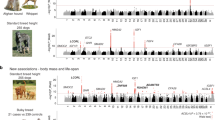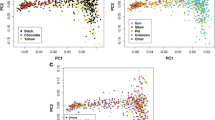Abstract
Inbreeding poses a real or potential threat to nearly every species of conservation concern. Inbreeding leads to loss of diversity at the individual level, which can cause inbreeding depression, and at the population level, which can hinder ability to respond to a changing environment. In closed populations such as endangered species and ex situ breeding programs, some degree of inbreeding is inevitable. It is therefore vital to understand how different patterns of breeding and inbreeding can affect fitness in real animals. Domestic dogs provide an excellent model, showing dramatic variation in degree of inbreeding and in lifespan, an important aspect of fitness that is known to be impacted by inbreeding in other species. There is a strong negative correlation between body size and lifespan in dogs, but it is unknown whether the higher rate of aging in large dogs is due to body size per se or some other factor associated with large size. We used dense genome-wide SNP array data to calculate average inbreeding for over 100 dog breeds based on autozygous segment length and found that large breeds tend to have higher coefficients of inbreeding than small breeds. We then used data from the Veterinary medical Database and other published sources to estimate life expectancies for pure and mixed breed dogs. When controlling for size, variation in inbreeding was not associated with life expectancy across breeds. When comparing mixed versus purebred dogs, however, mixed breed dogs lived about 1.2 years longer on average than size-matched purebred dogs. Furthermore, individual pedigree coefficients of inbreeding and lifespans for over 9000 golden retrievers showed that inbreeding does negatively impact lifespan at the individual level. Registration data from the American Kennel Club suggest that the molecular inbreeding patterns observed in purebred dogs result from specific breeding practices and/or founder effects and not the current population size. Our results suggest that recent inbreeding, as reflected in variation within a breed, is more likely to affect fitness than historic inbreeding, as reflected in variation among breeds. Our results also indicate that occasional outcrosses, as in mixed breed dogs, can have a substantial positive effect on fitness.





Similar content being viewed by others
References
Abegglen LM, Caulin AF, Chan A et al (2015) Potential mechanisms for cancer resistance in elephants and comparative cellular response to DNA damage in humans. JAMA 314:1. https://doi.org/10.1001/jama.2015.13134
Austad SN, Fischer KE (2016) Sex differences in lifespan. Cell Metab 23:1022–1033. https://doi.org/10.1016/j.cmet.2016.05.019
Bannasch D, Young A, Myers J et al (2010) Localization of canine brachycephaly using an across breed mapping approach. PLoS ONE 5:e9632. https://doi.org/10.1371/journal.pone.0009632
Bellumori TP, Famula TR, Bannasch DL et al (2013) Prevalence of inherited disorders among mixed-breed and purebred dogs: 27,254 cases (1995–2010). J Am Vet Med Assoc 242:1549–1555. https://doi.org/10.2460/javma.242.11.1549
Bernaerts F, Talavera J, Leemans J et al (2010) Description of original endoscopic findings and respiratory functional assessment using barometric whole-body plethysmography in dogs suffering from brachycephalic airway obstruction syndrome. Vet J 183:95–102. https://doi.org/10.1016/j.tvjl.2008.09.009
Bernardi G (1988) Longevity and morbidity in the Irish wolfhound in the United States—1966 to 1986. Harp Hound 1:78–84
Borge KS, Tønnessen R, Nødtvedt A, Indrebø A (2011) Litter size at birth in purebred dogs-A retrospective study of 224 breeds. Theriogenology 75:911–919. https://doi.org/10.1016/j.theriogenology.2010.10.034
Boyko AR, Boyko RH, Boyko CM et al (2009) Complex population structure in African village dogs and its implications for inferring dog domestication history. Proc Natl Acad Sci USA 106:13903–13908. https://doi.org/10.1073/pnas.0902129106
Boyko AR, Quignon P, Li L et al (2010) A simple genetic architecture underlies morphological variation in dogs. PLoS Biol 8:49–50. https://doi.org/10.1371/journal.pbio.1000451
Brosnahan MM, Paradis MR (2003) Demographic and clinical characteristics of geriatric horses: 467 cases (1989-1999). J Am Vet Med Assoc 223:93–98. https://doi.org/10.2460/javma.2003.223.93
Calder WA (1984) Size, function, and life history. Harvard University Press, Cambridge
Cassinello J (2005) Inbreeding depression on reproductive performance and survival in captive gazelles of great conservation value. Biol Conserv 122:453–464. https://doi.org/10.1016/j.biocon.2004.09.006
Daniels TJ, Bekoff M (1989) Population and social biology of free-ranging dogs, Canis familiaris. J Mammal 70:754–762
Darwin C (1868) The variation of animals and plants under domestication. D. Appleton, New York
Delaneau O, Marchini J, Zagury J-F (2012) A linear complexity phasing method for thousands of genomes. Nat Methods 9:179–181. https://doi.org/10.1038/nmeth.1785
Dobson JM (2013) Breed-predispositions to cancer in pedigree dogs. ISRN Vet Sci 2013:941275. https://doi.org/10.1155/2013/941275
Eigenmann JE, Patterson DF, Froesch ER (1984) Body size parallels insulin-like growth factor I levels but not growth hormone secretory capacity. Acta Endocrinol (Copenh) 106:448–453
Fay JC, Wu CI (2000) Hitchhiking under positive Darwinian selection. Genetics 155:1405–1413
Fitzpatrick JL, Evans JP (2009) Reduced heterozygosity impairs sperm quality in endangered mammals. Biol Lett 5:320–323. https://doi.org/10.1098/rsbl.2008.0734
Fleming JM, Creevy KE, Promislow DEL (2011) Mortality in North American dogs from 1984 to 2004: an investigation into age-, size-, and breed-related causes of death. J Vet Intern Med 25:187–198
Genoscoper Laboratories Oy MyDogDNA Technical Sheet–Design, Technology, and Performance Data
Galis F, Van Der Sluijs I, Van Dooren TJM et al (2007) Do large dogs die young? J Exp Zool B 308B:119–126. https://doi.org/10.1002/jez.b.21116
Gilmore KM, Greer KA (2015) Why is the dog an ideal model for aging research? Exp Gerontol 71:14–20. https://doi.org/10.1016/j.exger.2015.08.008
Greer KA, Canterberry SC, Murphy KE (2007) Statistical analysis regarding the effects of height and weight on life span of the domestic dog. Res Vet Sci 82:208–214. https://doi.org/10.1016/j.rvsc.2006.06.005
Gusev A, Lowe JK, Stoffel M et al (2009) Whole population, genome-wide mapping of hidden relatedness. Genome Res 19:318–326. https://doi.org/10.1101/gr.081398.108
Hayward J, Castelhano M, Oliveira K et al (2016) Complex disease and phenotype mapping in the domestic dog. Nat Commun. https://doi.org/10.1038/ncomms10460
Hedrick PW, Kalinowski ST (2000) Inbreeding depression in conservation biology. Annu Rev Ecol Syst 31:139–162
Hoffman JM, Creevy KE, Promislow DEL (2013) Reproductive capability is associated with lifespan and cause of death in companion dogs. PLoS ONE 8:e61082. https://doi.org/10.1371/journal.pone.0061082
Hollingsworth MJ, Smith JM (1955) The effects of inbreeding on rate of development and on fertility in Drosophila subobscura. J Genet 53:295–314. https://doi.org/10.1007/BF02993984
Holzenberger M, Dupont J, Ducos B et al (2003) IGF-1 receptor regulates lifespan and resistance to oxidative stress in mice. Nature 421:182–187
Hughes AL, Yeager M (1998) Natural selection at major histocompatibility complex loci of vertebrates. Annu Rev Genet 32:415–435. https://doi.org/10.1146/annurev.genet.32.1.415
Hyde RR (1913) Inheritance of the length of life in Drosophila. Proc Indiana Acad Sci 23:113–123
Kaeberlein M, Creevy KE, Promislow DEL (2016) The dog aging project: translational geroscience in companion animals. Mamm Genome. https://doi.org/10.1007/s00335-016-9638-7
Khlat M, Khoury M (1991) Inbreeding and diseases: demographic, genetic, and epidemiologic perspectives. Epidemiol Rev 13:28–41
Klein JP, Moeschberger LP (2003) Survival analysis: statistical methods for censored and truncated data. Springer, New York
Kraus C, Pavard S, Promislow DEL (2013) The size-life span trade-off decomposed: why large dogs die young. Am Nat 181:492–505. https://doi.org/10.1086/669665
Larson G, Karlsson EK, Perri A et al (2012) Rethinking dog domestication by integrating genetics, archeology, and biogeography. Proc Natl Acad Sci USA 109:8878–8883. https://doi.org/10.1073/pnas.1203005109
Leroy G (2011) Genetic diversity, inbreeding and breeding practices in dogs: results from pedigree analyses. Vet J 189:177–182. https://doi.org/10.1016/j.tvjl.2011.06.016
Leroy G (2014) Inbreeding depression in livestock species: review and meta-analysis. Anim Genet 45:618–628. https://doi.org/10.1111/age.12178
Marsden CD, Ortega-Del Vecchyo D, O’Brien DP et al (2016) Bottlenecks and selective sweeps during domestication have increased deleterious genetic variation in dogs. Proc Natl Acad Sci 113:152–157. https://doi.org/10.1073/pnas.1512501113
Michell AR (1999) Longevity of British breeds of dog and its relationships with sex, size, cardiovascular variables and disease. Vet Rec 145:625–629. https://doi.org/10.1136/vr.145.22.625
Miller RA, Austad SN (2005) Growth and aging. Why do big dogs die young? Handb Biol Aging. https://doi.org/10.1016/B978-012088387-5/50022-4
Miller RA, Harper JM, Galecki A, Burke DT (2002) Big mice die young: early life body weight predicts longevity in genetically heterogeneous mice. Aging Cell 1:22–29
O’Neill DG, Church DB, McGreevy PD et al (2013) Longevity and mortality of owned dogs in England. Vet J 198:638–643. https://doi.org/10.1016/j.tvjl.2013.09.020
Olsson M, Meadows JRS, Truvé K et al (2011) A novel unstable duplication upstream of HAS2 predisposes to a breed-defining skin phenotype and a periodic fever syndrome in Chinese Shar-Pei dogs. PLoS Genet. https://doi.org/10.1371/journal.pgen.1001332
Patronek GJ, Waters DJ, Glickman LT (1997) Comparative longevity of pet dogs and humans: implications for gerontology research. J Gerontol A 52:B1717–B1718
Pearl R, Parker SL, Gonzalez BM (1923) Experimental studies on the duration of life. VII. The Mendelian inheritance of duration of life in crosses of wild type and quintuple stocks of Drosophila melanogaster. Am Nat 57:153–192
Peters RH (1986) The ecological implications of body size. Cambridge University Press, Cambridge
Peto R (1977) Epidemiology, multistage models, and short-term mutagenicity tests. Orig Hum Cancer 4:1403–1428
Poncet CM, Dupre GP, Freiche VG et al (2005) Prevalence of gastrointestinal tract lesions in 73 brachycephalic dogs with upper respiratory syndrome. J Small Anim Pract 46:273–279. https://doi.org/10.1111/j.1748-5827.2005.tb00320.x
Proschowsky HF, Rugbjerg H, Ersbùll AK (2003) Mortality of purebred and mixed-breed dogs in Denmark. Prev Vet Med. https://doi.org/10.1016/S0167-5877(03)00010-2
R Core Team (2014) R: a language and environment for statistical computing
Read AF, Harvey PH (1989) Life history differences among the eutherian radiations. J Zool 219:329–353. https://doi.org/10.1111/j.1469-7998.1989.tb02584.x
Rowell JL, McCarthy DO, Alvarez CE (2011) Dog models of naturally occurring cancer. Trends Mol Med 17:380–388. https://doi.org/10.1016/j.molmed.2011.02.004
Saint Bernard Club of America (1993) SBCA Health Survey. Saint Fancier 59–73
Samaras TT, Elrick H, Storms LH (2003) Is height related to longevity? Life Sci 72:1781–1802. https://doi.org/10.1016/S0024-3205(02)02503-1
Sewalem A, Kistemaker GJ, Miglior F, Van Doormaal BJ (2006) Analysis of inbreeding and its relationship with functional longevity in Canadian dairy cattle. J Dairy Sci 89:2210–2216. https://doi.org/10.3168/jds.S0022-0302(06)72291-3
Shannon LM, Boyko RH, Castelhano M et al (2015) Genetic structure in village dogs reveals a Central Asian domestication origin. Proc Natl Acad Sci 112:13639–13644. https://doi.org/10.1073/pnas.1516215112
Sutter NB, Eberle MA, Parker HG et al (2004) Extensive and breed-specific linkage disequilibrium in Canis familiaris extensive and breed-specific linkage disequilibrium in Canis familiaris. Genome Res. https://doi.org/10.1101/gr.3147604
Sutter NB, Bustamante CD, Chase K et al (2007) A single IGF1 allele is a major determinant of small size in dogs. Science (80-) 316:112–115
Tryfonidou MA, Holl MS, Vastenburg M et al (2003) Hormonal regulation of calcium homeostasis in two breeds of dogs during growth at different rates. J Anim Sci 81:1568–1580
Van Oosterhout CC, Zijlstra WG, van Heuven MK, Brakefield PM (2000) Inbreeding depression and genetic load in laboratory metapopulations of the butterfly Bicyclus anynana. Evolution (NY) 1:218–225. https://doi.org/10.1554/0014-3820(2000)054
Wayne RK, Ostrander EA (1999) Origin, genetic diversity, and genome structure of the domestic dog. BioEssays 21:247–257
Young JK, Olson KA, Sukh Amgalanbaatar RP, Berger J (2011) Is wildlife goint to the dogs? Impacts of feral and free-roaming dogs on wildlife populations. Bioscience 61:125–132. https://doi.org/10.1525/bio.2011.61.2.7
Author information
Authors and Affiliations
Corresponding author
Ethics declarations
Conflict of interest
Adam Boyko is the co-founder and Chief Science Officer of Embark Veterinary.
Additional information
Publisher's Note
Springer Nature remains neutral with regard to jurisdictional claims in published maps and institutional affiliations.
Electronic supplementary material
Below is the link to the electronic supplementary material.
Rights and permissions
About this article
Cite this article
Yordy, J., Kraus, C., Hayward, J.J. et al. Body size, inbreeding, and lifespan in domestic dogs. Conserv Genet 21, 137–148 (2020). https://doi.org/10.1007/s10592-019-01240-x
Received:
Accepted:
Published:
Issue Date:
DOI: https://doi.org/10.1007/s10592-019-01240-x




